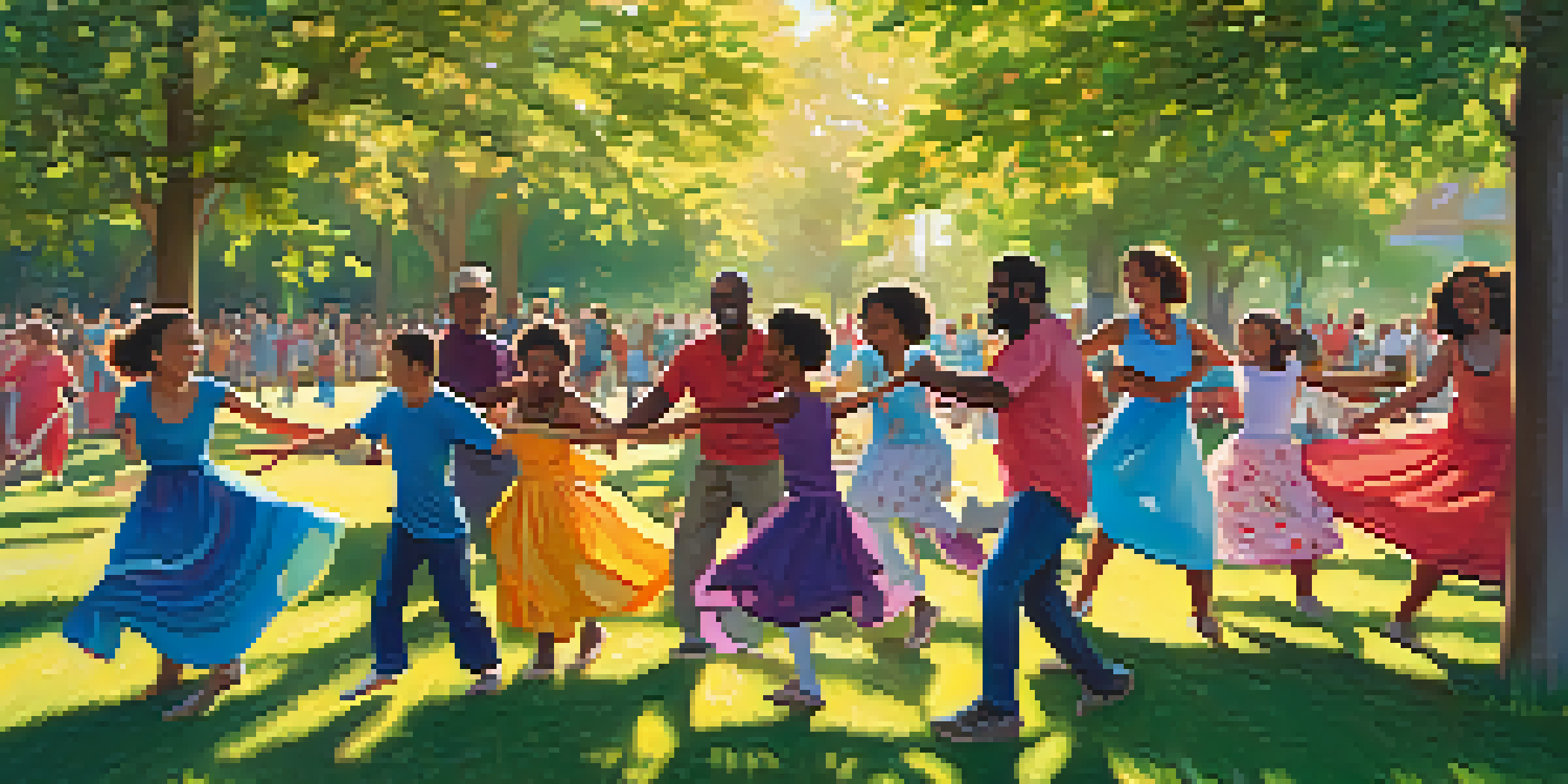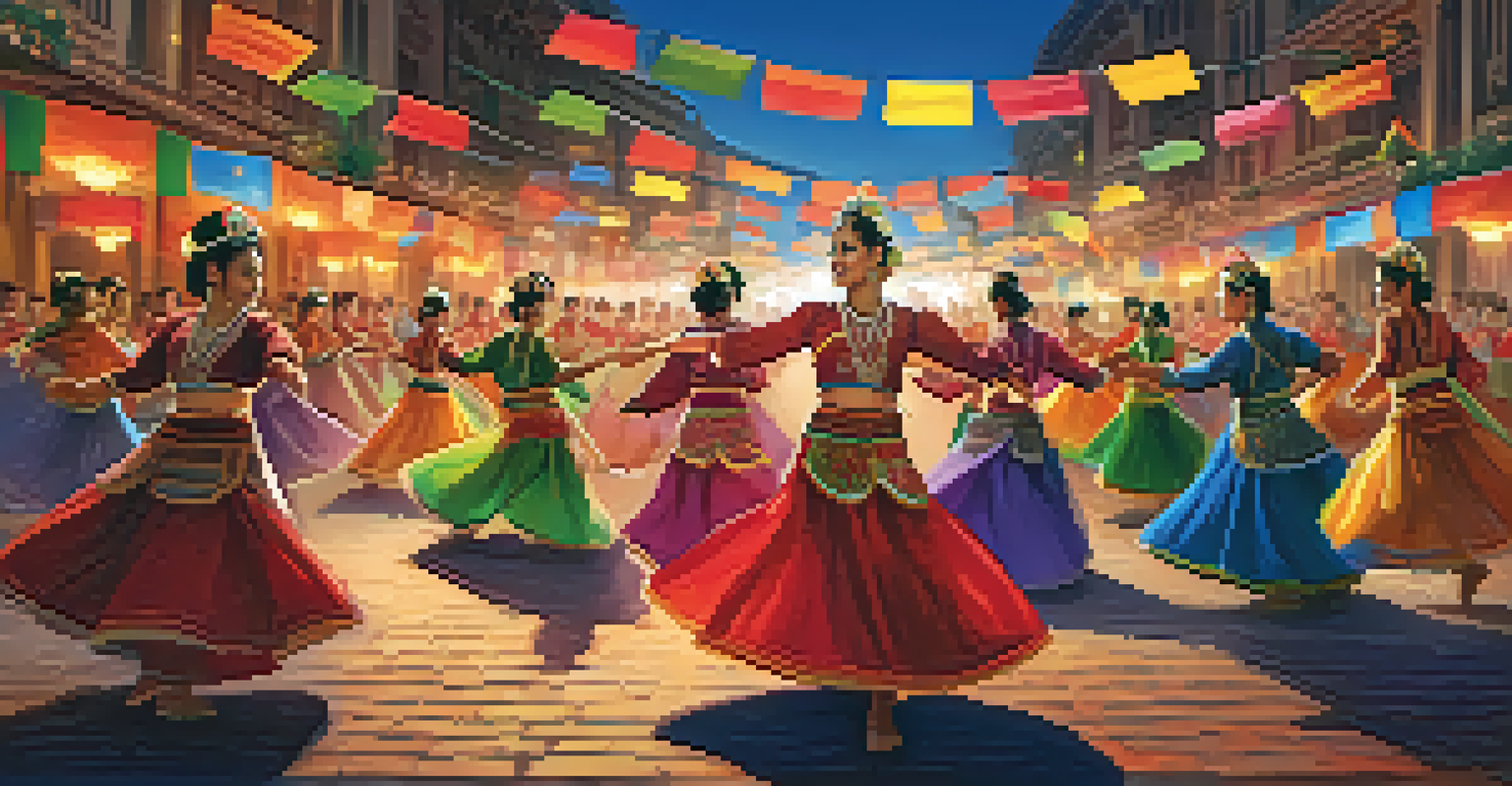Cultural Perspectives on Dance Therapy and Healing

Understanding Dance Therapy: A Global Overview
Dance therapy, or dance/movement therapy, combines movement and psychotherapy to promote emotional, cognitive, and physical integration. It’s used worldwide, from the bustling streets of New York to remote villages in Africa, highlighting its universal appeal. By expressing emotions through movement, individuals can explore their inner selves in a non-verbal way, making it accessible to people of all backgrounds.
Dance is the hidden language of the soul.
In various cultures, dance is not just an art form but also a means of healing. For instance, Indigenous cultures often incorporate dance in rituals aimed at healing both the individual and the community. This reflects a belief that physical movement can restore balance and harmony, which is central to many therapeutic practices across the globe.
Moreover, the effectiveness of dance therapy can be seen in how it adapts to different cultural contexts. In some cultures, group dances foster a sense of community and shared healing, while in others, solo expression may be emphasized. This adaptability is one of the reasons dance therapy resonates with so many people, regardless of their cultural background.
Cultural Traditions: Dance as a Healing Practice
Throughout history, dance has been integral to cultural rituals and healing practices. For example, in African cultures, dances often accompany healing ceremonies, with the belief that rhythm and movement can drive away negative energies. This cultural perspective enhances the therapeutic process by embedding it in rich traditions that foster community support.

Similarly, in Eastern traditions, practices like Tai Chi and Kathak dance are recognized not only for their physical benefits but also for their meditative qualities. These dance forms encourage mindfulness, helping participants to connect their body and mind, thereby promoting holistic healing. The cultural significance attached to these movements amplifies their therapeutic value.
Dance Therapy's Global Appeal
Dance therapy transcends cultural boundaries, offering a universal method for emotional expression and healing.
The integration of dance in healing practices emphasizes the connection between the individual and their cultural identity. When people engage in culturally relevant dances, they often feel a deeper emotional resonance, as these activities can evoke memories and feelings tied to their heritage. This connection can be a powerful catalyst for healing.
Dance Therapy in Western Contexts: A New Approach
In Western contexts, dance therapy has gained recognition as a legitimate therapeutic approach, particularly within mental health settings. Therapists utilize dance to help clients express feelings that may be hard to articulate verbally. This focus on movement as a form of expression allows individuals to explore their emotions in a safe environment.
Movement is a medicine for creating change in a person's physical, emotional, and mental states.
Western dance therapy often emphasizes individualism, with practitioners tailoring sessions to address personal issues, such as trauma or anxiety. This personalized approach can be immensely beneficial, as it empowers clients to take charge of their healing journey. However, it can sometimes lack the communal aspect found in many non-Western traditions.
Despite these differences, there's a growing interest in blending Western and Eastern practices. Many therapists are now incorporating traditional dance elements into their sessions, recognizing the benefits of a more holistic, culturally inclusive approach. This fusion not only enriches the therapy but also honors the diverse backgrounds of clients.
The Role of Community in Dance Therapy
Community plays a crucial role in the effectiveness of dance therapy. In many cultures, dance is a communal activity that fosters connection and support, enhancing the healing process. Group dance sessions can create a sense of belonging, helping individuals feel less isolated in their struggles.
For example, community dance projects often bring together diverse groups, allowing participants to share their stories through movement. This shared experience can lead to deeper understanding and empathy among participants, creating a supportive network that promotes collective healing. The shared rhythm of movement can unify participants, making the therapy experience more impactful.
Cultural Significance in Healing
Integrating traditional dance forms into therapy enhances emotional resonance and connection to cultural identity.
Furthermore, the sense of community built in these sessions can have lasting effects beyond the dance floor. Participants often carry the connections they’ve made into their everyday lives, fostering ongoing support and friendship. This highlights how dance therapy not only aids individual healing but also strengthens communal bonds.
Dance Therapy for Trauma: A Cultural Lens
Trauma can manifest in many forms, and dance therapy provides a unique way to address these issues across cultures. In cultures where verbal expression may be limited, movement offers an alternative outlet for those who have experienced trauma. This is particularly true in communities that emphasize non-verbal communication.
For instance, in refugee communities, dance therapy has been used to help individuals process their experiences through movement, allowing them to express pain, loss, and resilience. This approach not only aids healing but also validates their experiences in a culturally sensitive way. Dance becomes a powerful medium through which trauma can be transformed into expression.
Moreover, the integration of traditional dances in therapy can evoke cultural memories, providing a sense of identity and belonging. This is especially important for individuals navigating the complexities of trauma, as reconnecting with one's cultural roots can foster resilience and hope. Ultimately, dance therapy becomes a bridge between past experiences and present healing.
Modern Science Meets Traditional Healing: Research Insights
As interest in dance therapy grows, so does the body of research supporting its benefits. Studies have shown that engaging in dance can reduce stress, improve mood, and enhance overall well-being. This scientific backing is crucial for gaining acceptance in more traditional healthcare settings, making a case for the integration of dance therapy into standard treatment protocols.
Research has also explored how culturally specific dance forms can enhance the therapeutic experience. For example, studies indicate that participants who engage in culturally relevant dance report higher levels of satisfaction and emotional release. This highlights the importance of tailoring therapy to fit cultural contexts, making it more effective.
Community's Role in Healing
Group dance sessions foster a sense of belonging and support, making the healing process more impactful.
Moreover, modern neuroscience has begun to unravel the connections between movement and emotional processing. By understanding how dance activates various parts of the brain, researchers can better appreciate why dance therapy is an effective healing tool. This marriage of science and tradition paves the way for a deeper understanding of the therapeutic power of dance.
Future Directions: A Global Perspective on Dance Therapy
The future of dance therapy is poised to be even more inclusive and diverse, reflecting a global tapestry of practices and beliefs. As therapists increasingly draw from various cultural traditions, we can expect to see a richer, more varied approach to healing. This will not only benefit clients but also honor the cultural origins of these therapeutic practices.
Additionally, the rise of technology in therapy—such as virtual dance sessions—opens new avenues for global participation. Individuals from different backgrounds can connect and share their unique dance traditions, fostering a more inclusive therapeutic environment. This can lead to cross-cultural exchanges that enrich both the practice and the participants' experiences.

Looking ahead, it's essential to continue advocating for the integration of dance therapy in mental health services worldwide. As awareness of its benefits grows, more individuals can access this powerful form of healing. By embracing a global perspective, we can ensure that dance therapy evolves as a dynamic and culturally relevant practice.